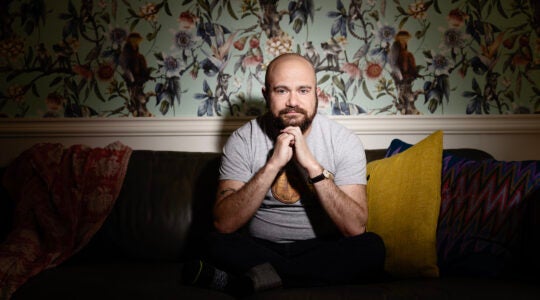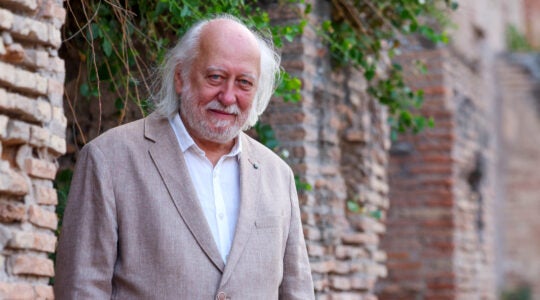MADRID (JTA) – Even at 94 and with eyes that barely see, Angela Pipano vividly recalls her memories of life as a child in Salonika, Greece.She remembers a city with more Jews than Greeks or Turks, the port being closed on the Jewish Sabbath and Ladino as the language heard most on the street. The Jews who were
expelled from Spain in 1492 and their descendants spoke Ladino, or Judeo-Spanish. It was a language of
the Diaspora, much like Yiddish.”There was just one [Jewish] woman in all Salonika who could speak another language,” Pipano says. “All the rest of them, our mothers, spoke only Ladino.”The Nazi occupation sent Pipano fleeing from her home. A high-ranking Nazi official in the occupation forces was an old schoolmate of her German-educated husband, and the official warned
them of what was to come. They fled into the mountains, then to
British Mandate Palestine and finally to Spain – Sefarad, as it
is known in Ladino.Here, in the land of her ancestors, non-Jews in Spain are undergoing a resurgence of interest in their Sephardic heritage. And with Ladino derived from medieval Castillian Spanish, the interest has spread to the government agency that promotes Spanish.At Cervantes Institute headquarters in Madrid, academic director Jorge Urrutia shows a reporter a
shelf filled with Ladino poetry.”When I was in Istanbul some
years ago, an older gentleman came up to me,” Urrutia recalls. “He handed me book of
poems and he spoke to me in Ladino. It was a very
personal experience of how Judeo-Spanish is a language that has
survived 500 years, spanning cultures, geography and the vicissitudes
of history.”The Cervantes Institute has been sponsoring Ladino readings and
seminars at its branches in Tel Aviv, Istanbul, Bucharest and Sofia. Now Urrutia says the institute will create a
Ladino Department with a Judeo-Spanish archive at its headquarters in Madrid. And Ladino will be the focus of a new Cervantes Institute in
Salonika, which will be located next to the city’s Sephardic
Museum.Today there are an estimated 200,000 Ladino speakers, mostly in Israel,
according to Israel’s National Ladino Authority. But most are elderly,
so the tongue is in danger of extinction.Pipano has difficulty remembering her native tongue. As she sits in her apartment and tells the story of her life, she repeatedly lapses into Spanish. The two languages are quite similar. For example, the Spanish word for shirt is “camisa,” while in Ladino it’s “camiza.” “Tarde,” which means “afternoon” in Spanish, is “tadre” in Ladino. And “I remember” is not “me acuerdo” but “me acodro.””Me acodro cosas” – “I remember things,” Pipano says.Things like the great Salonika fire of 1917. And the Holocaust, which devastated Salonika’s Jewish community along with many other Ladino-speaking communities in the Balkans.Another effort to preserve Ladino is at Spanish National Radio’s overseas service. Matilda Barnatan and her daughter, Viviana Rajel, broadcast a show in Ladino featuring music, poetry and interviews in the language.”We want to show that this is not a dead language,” says Barnatan, who learned Ladino from her grandmother, a native of the Greek island of Rhodes. “In killing the people whospoke it in the second world war, [the Nazis] killed a big part of a culture. That’s why we have the obligation to carry it on.”In Yiddish, a modern revival has included theater and journalism, and it received a boost from Nobel laureate Isaac Bashevis Singer, who wrote in the mother tongue.The Ladino revival has been more modest. Ladino was the mother tongue of the late Elias Canetti, a Bulgarian-born Sephardic novelist who won a Nobel in 1981. But he wrote in German.Madrid-based author Esther Bendahan produces “Shalom,” a program about Judaism and Sephardic culture on Spanish television. In her novels, Sephardic Jews in her native Morocco often use expressions in Haquitia, the variant of Judeo-Spanish spoken by Sephardim in Morocco.But even Bendahan believes there are limits on what a novelist should do to resuscitate a language.”I’m not going to start writing novels in Judeo-Spanish,” she says. “You can’t insist on preserving it at all cost. It should be something natural and spontaneous.”Bendahan says young Jews in Madrid are using Haquitia as slang, a bit like Yiddish in some conversations in New York, Amsterdam and other places.Like the other day, she says her daughter brought home a male friend and Bendahan used a Haquitian word. She thought he wouldn’t understand when she said he was “khial,” which means “good looking.””But,” Bendahan says, “it turns out he did know what it means.”
JTA has documented Jewish history in real-time for over a century. Keep our journalism strong by joining us in supporting independent, award-winning reporting.





